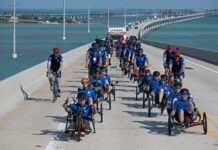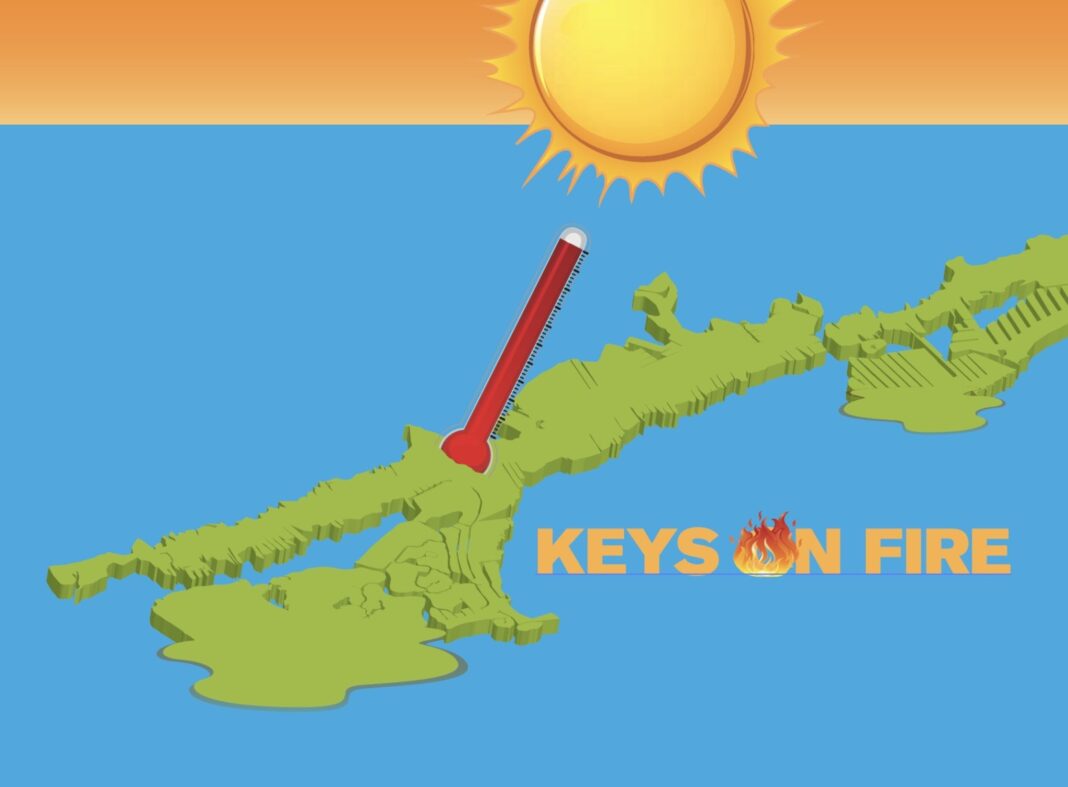By Mandy Miles & Jim McCarthy
“Good lord, it’s hot.”
“What the hell? It’s only July. What’s gonna happen in August and September?”
“This is insane.”
Every conversation in the Florida Keys this month includes some mention of the unprecedented heat that hangs over the island chain like a damp beach towel.
So what’s the deal? How much hotter is it than normal? How many heat records have the Florida Keys broken? What does all this A/C use mean for our power supply? And most importantly, what are the health risks and how can you keep your family safe?
Read on for answers to all of the above.
First, the temperatures….
We don’t need a meteorologist to tell us it’s hot, but the Keys Weekly wanted to know just how this month’s temperatures compare to years past.
Meteorologist David Ross at the National Weather Service’s Key West forecast office took the time to review July weather records dating back to 1871 for Key West and back to 1950 for Marathon.
Those two locations had broken 28 records by July 17, with higher-than-ever temperatures — or at least higher than any others on the same date in previous years. Another record-breaking trend has occurred with our higher-than-usual low nighttime temperatures, which haven’t offered much relief in recent weeks.
“It’s been a pretty impressive stretch of record-breaking temperatures and broken records,” Ross said, acknowledging that “impressive,” doesn’t mean “comfortable.”
“Marathon’s nighttime low temperature hasn’t gone below 80 degrees since July 6,” Ross said. “From July 12-16, the low was 86, which ties the monthly record for low temperatures in July.”
Ross acknowledged recent media reports that partially attribute Marathon’s record-setting heat on the location of its weather sensor at the Marathon/Florida Keys Airport.
“It’s true, that sensor is in an area that can be hotter, but that doesn’t change the fact that this has been the warmest July ever recorded,” he said.
“But this is not the new normal; this is a heat wave,” Ross said, adding that the dearth of rainfall — and the accompanying cloud cover — has contributed greatly to the high temperatures this month. Rainfall is typically highest in the Keys in August and September, Ross said.
“An increase in rainfall is the main thing that’ll help bring us back to average temperatures.”
Unfortunately, he added, there’s no cold front on the horizon that will bring any relief.
Now for power consumption
Officials at Keys Energy Services (KEYS) recently dispelled rumors claiming the record-breaking temps and nonstop hum of our air-conditioners could suck up too much electricity and lead to power outages.
It’s true, the electric company set a record on July 12 for the most power ever used in a single day in KEYS’ service area, which stretches from Key West to the Seven Mile Bridge. But there is plenty of power to keep us all cool, utility spokesman Julio Torrado assured us. In addition to the electricity that travels from the mainland, down the tieline along the length of the Keys, the utility is supplementing that power by generating some locally at the Stock Island power plant.
“The heat is definitely leading to increased power consumption by our customers, but the power grid is able to withstand this demand,” Torrado said. “…For the last few weeks local generation has been utilized to generate power during peak usage times (approximately 2 to 7 p.m.) and to help reduce the power import load on the transmission line.
In the Middle and Upper Keys, Florida Keys Electric Cooperative customers are also bumping their thermostats down as the intense heat keeps a stranglehold on the Keys. Power generation has increased in FKEC’s coverage area. But the rise in electricity to pump air conditioners and cooling systems isn’t overwhelming the system.
“The heat is causing an increase in demand for electricity but FKEC has plenty of excess capacity to handle it,” said Nikki Dunn Cullen, FKEC marketing and public relations representative.
FKEC said people can offset extra power consumed by their cooling systems by installing high-reflective windows, which can reduce heat gain by 45% or medium-color draperies with white-plastic-backed drapes, which can reduce heat gain by 33%.
And now for the health hazards and safety tips….
Hot weather places extra stress on the body by elevating body temperature, especially during exercise. Per the Florida Health Department, overheating can bring everything from heat cramps and heat exhaustion to heatstroke. Elderly people are more likely to suffer from heat stress than others, but heat-related illnesses can affect anyone subjected to high temperatures for an extended period of time.
Officials with the Florida Health Department of Monroe County urge Keys residents and visitors to drink plenty of water throughout the day to avoid dehydration. Also, avoid strenuous activities during peak hours.
Dr. Metee Comkornruecha, of Florida Keys Pediatrics in Tavernier, said sun protection for children is paramount this time of year.
“Sometimes we don’t realize a couple extra hours under the sun can lead to second-degree and third-degree burns. It’s not just a little bit of red in the skin,” he said. “The skin can blister and can be a lot more dangerous.”














